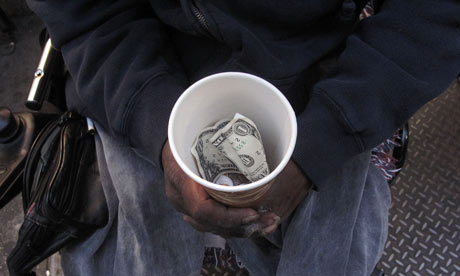Poverty - A Risk Factor for Mental and Behavioral Health
- Details
- Published on January 03, 2012
Poverty is a growing problem in the U.S. According to an Index Mundi ranking that uses poverty statistics from the CIA World Factbook, twenty-two countries in the world report lower percent of their population living below the poverty line than the United States. (Index Mundi, 2011) According to the Organization for Economic Cooperation and Development (OECD), measuring poverty as living below 50% of the median income, only Turkey and Mexico have higher poverty rates among the 34 countries tracked, and the U.S. is highest among the developed countries. (OECD, 2011)

Socio-economic factors are weighted more heavily among health-related variables that impact health outcomes (morbidity and mortality). Social and economic factors include education, employment, income, family and social support and community safety. (The Robert Wood Johnson Foundation & University of Wisconsin Population Health Institute, 2011) Research has repeatedly affirmed that poverty is a major determinant of poor health. (Bloch, Rozmovits, & Giambrone, 2011). A relationship has been found between on-going high unemployment rates and heightened risks and incidence of suicide. (SAMHSA, 2011, p. NCMH/13.
As poverty increases or decreases, so do the indices of health problems (Bisgaier and Rhodes 2011) and social problems. (IOM Panel, 2011; IOM, 2009, p. 177; Duncan, Ziol Guest, & Kalil, 2010) According to the Institutes of Medicine, poverty is at least as important as other risk factors and may be the number one risk factor for children for problem development (IOM Panel, 2011):
Family poverty and the economic strains associated with such events as job loss frequently undermine family functioning. They are associated with multiple negative behavioral outcomes among children in these families, increased parental depression and spousal and parent-child conflict, and undermine effective parenting. (IOM, 2009, p. 176)
The National Center for Children in Poverty (NCCP) at Columbia University reports that nearly 15 million children live in families with income below the federal poverty level ($22,050 for a family of four -- two parents and two children). (NCCP, 2011) Child poverty is higher than ever in the past fifty years. Research from the Annie E. Casey Foundation (2011) finds 22% of US children in poverty in 2010 and reports increases in child poverty in 2010 across 38 states, including Indiana (at 22%) Moreover, poverty is not evenly distributed across population groups. Figures from Childstats.gov show that nearly 36% of Black children, compared with 33% of Hispanic and 12% of White children live below 100% Poverty. Children living in extreme poverty (below 50% poverty) consist of 18% Black children, 14% of Hispanic children and 5% of White children. (Child Stats.gov, 2011) According to the NCCP, âResearch is clear that poverty is the single greatest threat to childrenâs well-being.â
In contrast to an earlier belief that poverty during adolescence was most damaging, recent research finds that experiencing poverty in early childhood (birth to age 5) creates greater risk for future poor health. Duncan, Kalil and Ziol-Guest found that children poor in their early years are more than two times more likely to suffer poor overall health and elevated stress levels as adults than children who do not experience poverty. (Duncan et al, 2010) Where parents are suffering financial problems, the entire family is impacted. Parents under stress from poverty argue more and the extremely important nurturing environment is strained. Some ways to combat poverty include a living wage, access to health care, increased benefits, food programs, and enterprise zones where impoverished areas in which incentives such as tax concessions are offered to encourage investment and provide jobs for residents. (IOM Panel, 2011)
The challenge of poverty can be overcome. Mental, emotional and behavioral health is influenced by the interplay of the environment and genetic factors. Where children have considerable positive influences or protective factors in their environments, such as positive role models, strong early attachments and social relationships and personal characteristics (like self-regulatory control, communication and problem solving skills), they can achieve healthy development. (IOM, 2009; Leve, Fisher, & Chamberlain, 2009) These resilient young people can continue to thrive and from their experience of poverty gain a heightened capacity for comprehension, empathy and inspiration.
For more information about poverty and mental health as well as resources for help in Indiana please visit the Rural Assistance Centerâs website at http://www.raconline.org/states/indiana.php.



 A total of 8,059 students 18-25 years
of age from 23 Indiana colleges participated in the Indiana College Substance Use Survey conducted in Spring 2021.
A total of 8,059 students 18-25 years
of age from 23 Indiana colleges participated in the Indiana College Substance Use Survey conducted in Spring 2021.








